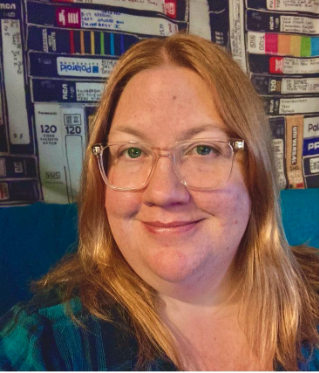Speakers: Maddie Brueger (University of Texas at Austin), Megan Mericle (Georgia Institute of Technology), Alba Newmann Holmes (Swarthmore College)
At a conference where most panels centered on the expanding influence of generative AI, “Moving through Space” closed out the conference by refreshingly turning our attention to embodiment, place, and the “more-than-human” world. Each presentation explored different means of surfacing the ecological and rhetorical entanglements that shape everyday life. Whether through thermal imaging, citizen science networks, or digital mapping projects, the panelists offered accounts of how movement and environment co-create knowledge and how rhetoric can intervene in climate crisis not just through critique but through fostering self-reflection.
Maddie Bruegger opened the session by taking us from her previous home on a small island in Maine to a heat island in Austin, Texas. These urban heat islands—densely developed areas prone to heat retention—pose increasing public health risks as global temperatures rise. While Austin has attempted to mitigate these effects through the creation of “cool corridors,” Bruegger’s research complicates how we understand the labor of these green infrastructures. Equipped with a thermal camera during a walk through one of these corridors, she noticed something unexpected: the trees shading the path were actually hotter than their surroundings. This moment led her to develop the practice of “thermal witnessing walks”: a form of speculative rhetoric that captures the felt, embodied experience of heat and reveals human and more-than-human entanglements through thermal photography. Her research now includes a community-engaged project where participants will take part in their own “witnessing walks,” using thermal cameras to capture images and collect written observations in zines as both a method of data collection and an embodied rhetorical intervention. Drawing on the work of Kynard (2020) and Houdek (2021), Bruegger frames this participatory method as a form of academic smuggling: bringing the resources of the university into under-resourced communities to advocate for more equitable access to cooling infrastructure. As she noted during the Q&A, Austin officials are primarily interested in quantitative data, so her project seeks to pair that data with the experiential, capturing what it feels like to move through extreme heat and what it means to see it differently.
Megan Mericle’s presentation shifted the focus to citizen science as a site of rhetorical complexity and contested authority. Framing climate change as a “wicked problem” in the Rittel and Webber (1973) sense—difficult to define, with no clear endpoint—Mericle explored how citizen science disrupts traditional flows of expertise. These participatory projects involve non-experts in data collection tasks like insect tracking or rainfall measurement, challenging the unidirectional model of science communication and opening up space for more collaborative and sometimes contradictory rhetorical practices. Her case study on CoCoRaHS (the Community Collaborative Rain, Hail, and Snow Network) revealed tensions between professional neutrality and political advocacy. While the Illinois state coordinator of CoCoRaHS took a deferential stance toward climate change denial hoping the evidence would “speak for itself,” a county coordinator used her role more explicitly to advocate for climate education in local political spaces. Mericle highlighted how participants’ rhetorical identities shift depending on context: scientist, citizen, neighbor, advocate. These boundary-crossing moves complicate the binary of objective researcher and political actor, revealing instead a network of strategic positionings. Through this lens, Mericle asked us to reconsider what constitutes expertise and how citizen science might serve not only as a research method but as a rhetorical practice of public engagement.
Rounding out the panel, Alba Newmann Holmes invited us into a retrospective look at her course “Walking as a Way of Knowing” which treats movement itself as a mode of inquiry. Framing the essay form as both a journey and a genre, the class asks students to walk with intention and compose multimodal projects around themes such as Walking and the Self, Nature, the City, and Social Change. The projects she shared were rich, varied, and deeply personal: a transnational sound collage documenting students’ movements across borders during the pandemic; a relatively standard written essay partially obscured by an image of a tree branch, inviting the reader to look through language as one might through foliage; and a zine on mushroom foraging combining photos, sketches, and field notes among others. Students used Google Maps, Padlet, and personal photography to track their routes and annotate the spaces they moved through. For example, one project juxtaposed promotional images of public spaces with the student’s own photographs, challenging commercial framings of space by reasserting human scale and embodied perspective. Other students—building on Garnette Cadogan’s “Walking While Black” (2015)—explored the racialized dimensions of mobility and surveillance. Newmann Holmes closed by sharing that she and her students are working to create a digital archive of these walking essays. She asked us to consider: how might digital technologies—from GPS to zines to smartphones—help us foster deeper connections to the spaces we inhabit? And how might we, as writing instructors, draw on the affordances of the essay form to help students map those connections?
This panel offered a much-needed counterpoint to the dominant AI-focused discourse of the conference by drawing attention to the flipside of AI proliferation: escalation of climate change. If generative AI asks what machines can write for us, these presenters ask what it means to compose with our bodies, our environments, and our communities. Their work reminds us that writing can be a way of witnessing: of heat, of place, of change. And in a moment defined by climate precarity, this work feels like a crucial intervention.

